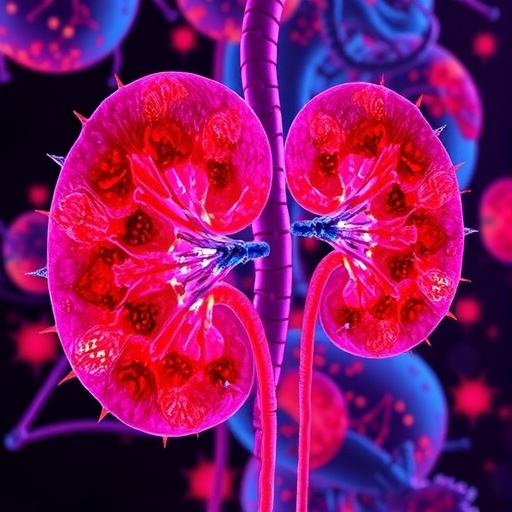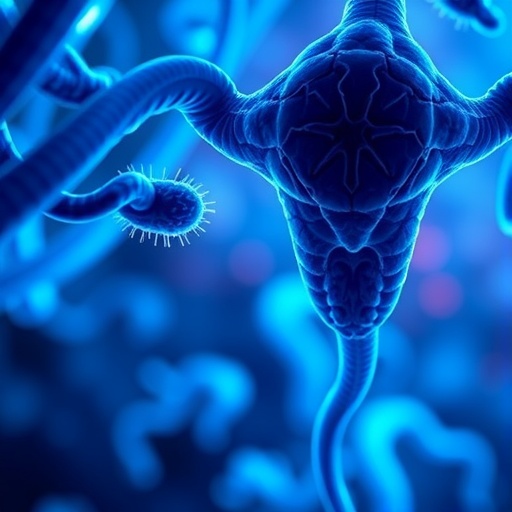In a remarkable advancement that could reshape our understanding and treatment of kidney diseases, a team of researchers has leveraged cutting-edge multiomic technologies to uncover novel insights into human kidney pathology. The study, published in Nature Communications, dives deep into the cellular and molecular landscape of diseased human kidneys, revealing a distinct tubular cell phenotype characterized by inflammatory and pro-fibrotic activity. This discovery paves the way for potential therapeutic interventions that specifically target these maladaptive cellular states, marking a significant milestone in nephrology research.
Kidney diseases remain a leading cause of morbidity and mortality worldwide, yet treatments have been largely symptomatic, with limited capacity to reverse or halt disease progression. Central to many forms of kidney disease is fibrosis—a scarring process that irreversibly impairs organ function. Despite its clinical importance, the precise cellular and molecular drivers underpinning fibrosis in the human kidney are not fully understood. This knowledge gap has hindered the development of effective therapies. The current study’s application of multiomics—a comprehensive analytical approach combining genomics, transcriptomics, proteomics, and epigenomics—provides a holistic view of kidney tissue, enabling dissection of complex cellular phenotypes involved in disease.
The researchers meticulously analyzed kidney biopsy samples from patients representing a spectrum of inflammatory kidney diseases. By integrating data from single-cell RNA sequencing, chromatin accessibility assays, protein expression profiles, and metabolomic analyses, they identified a unique tubular epithelial cell population that acquires both inflammatory and pro-fibrotic features. These cells, normally tasked with reabsorbing solutes and maintaining tubular integrity, appear to adopt a pathological state characterized by elevated expression of cytokines, chemokines, and extracellular matrix components. The comprehensive profiling allowed the team to pinpoint specific signaling pathways and transcription factors orchestrating this phenotypic transformation.
Critically, the study uncovers that this maladaptive tubular cell phenotype is not static but dynamically regulated by local microenvironmental cues, including interactions with immune cells and fibroblasts. This insight highlights the importance of the kidney’s cellular milieu in shaping disease progression, suggesting that targeting cell-cell communication networks could modulate fibrosis development. Moreover, these findings challenge the traditional view that fibroblasts are the sole mediators of fibrosis, implicating tubular epithelial cells themselves as active participants and potential therapeutic targets.
The multiomic approach employed exemplifies the power of integrating complementary high-throughput techniques to decode cellular heterogeneity and identify disease-driving cellular states. Single-cell transcriptomics revealed extensive heterogeneity among tubular cells, while epigenomic data identified enhancer elements and transcriptional regulators modulating gene expression programs associated with inflammation and fibrosis. Proteomic data corroborated these findings at the protein level, and metabolomic analyses uncovered metabolic rewiring accompanying the phenotypic shift. This multi-layered insight affords an unprecedented resolution of the disease landscape.
One of the most striking revelations from this study is the identification of several tractable molecular targets within the pro-fibrotic tubular cell population. These include surface receptors and intracellular signaling nodes amenable to pharmacological intervention, opening the door to the development of kidney-specific anti-fibrotic therapies. Unlike systemic anti-inflammatory drugs with broad effects and potential side effects, therapies directed at these specific cell populations promise a more precise, efficacious approach with lower toxicity.
Further exploration revealed that components of the transforming growth factor-beta (TGF-β) signaling pathway were prominently upregulated in the pro-fibrotic tubular cells, corroborating TGF-β’s well-established role in fibrosis. However, the study also identified novel modulators and co-factors that fine-tune the pathway’s activity in this unique cellular context. Targeting these modulators may enable more nuanced therapeutic strategies that suppress fibrosis while preserving essential physiological functions.
Importantly, the team validated their findings across multiple patient cohorts and disease etiologies, underscoring the robustness and generalizability of the pro-fibrotic tubular cell phenotype. This broad applicability suggests that therapies developed from these insights could benefit a wide range of patients suffering from chronic kidney diseases of diverse origins. It also raises the potential for developing biomarkers based on this cell phenotype to monitor disease progression and response to therapy.
The implications of this research extend beyond kidney disease. Fibrosis is a common pathological feature in multiple organs including the lung, liver, and heart. The concept that epithelial cells may acquire pro-fibrotic properties under inflammatory conditions may represent a conserved mechanism in fibrotic diseases at large. Thus, the study offers a conceptual framework that invites similar multiomic investigations in other organ systems, potentially revolutionizing the understanding and treatment of fibrosis systemically.
A technical highlight of the study is the integration of spatial transcriptomics with single-cell data, allowing the researchers to map the spatial distribution of inflammatory and pro-fibrotic tubular cells within kidney tissue architecture. This spatial context is crucial for understanding how these cells interact with the immune compartment and extracellular matrix, informing how fibrotic foci develop and expand. Such spatially resolved insights enhance both biological understanding and therapeutic targeting strategies.
In addition to identifying pathological mechanisms, the study also provides a valuable resource for the scientific community — a comprehensive multiomic atlas of human kidney disease. This atlas is expected to serve as a reference for ongoing and future research, enabling scientists worldwide to probe the complex cellular ecosystems driving kidney pathology. The open accessibility of this resource anticipates accelerating discoveries elsewhere in nephrology.
From a clinical perspective, one of the exciting prospects arising from this work is the potential for personalized medicine approaches. By characterizing patient-specific cellular phenotypes and molecular signatures, clinicians may be able to stratify patients more precisely, tailoring therapies to the unique disease mechanisms active in each individual. This precision paradigm could vastly improve treatment outcomes compared to current one-size-fits-all protocols.
The intersection of inflammation and fibrosis as illuminated in this study underscores the intricate balance between immune responses and tissue remodeling underlying kidney disease. While inflammation initiates protective mechanisms, chronic activation leads to maladaptive changes such as fibrosis. The identified tubular cell phenotype exemplifies this duality, being both a participant in inflammatory signaling and a driver of fibrotic scarring. Therapeutic modulation aimed at restoring this balance holds great promise for halting or reversing disease progression.
Beyond translational implications, the study exemplifies the transformative power of multiomics in biomedical research. By transcending traditional single-discipline analyses, the researchers have constructed a multidimensional view of disease biology. This holistic perspective is increasingly recognized as essential for unraveling complex pathologies and developing the next generation of targeted therapies. The methods and insights gleaned here will likely inspire similar approaches across other chronic diseases.
While the road from discovery to clinical application remains challenging, this seminal work establishes a solid foundation for drug development targeting the newly characterized tubulointerstitial niche. Future studies will need to validate candidate therapeutic agents in preclinical models and ultimately in clinical trials. Nonetheless, the delineation of a tractable pro-fibrotic tubular cell population represents a beacon of hope for the millions afflicted by kidney diseases.
In conclusion, through sophisticated multiomic analyses, the study by Reck, Baird, Veizades, and colleagues provides profound insights into the cellular underpinnings of human kidney disease. The identification of an inflammatory and pro-fibrotic tubular cell phenotype fundamentally shifts our understanding of fibrosis genesis in the kidney and reveals promising avenues for targeted therapy. As kidney disease continues to pose a global health challenge, such pioneering research fuels optimism for transformative advances in treatment and patient care.
Subject of Research: Human kidney disease; multiomic analysis; inflammatory and pro-fibrotic tubular cell phenotype.
Article Title: Multiomic analysis of human kidney disease identifies a tractable inflammatory and pro-fibrotic tubular cell phenotype.
Article References:
Reck, M., Baird, D.P., Veizades, S. et al. Multiomic analysis of human kidney disease identifies a tractable inflammatory and pro-fibrotic tubular cell phenotype. Nat Commun 16, 4745 (2025). https://doi.org/10.1038/s41467-025-59997-4
Image Credits: AI Generated
Tags: biopsy analysis in nephrologycellular drivers of kidney diseasechronic kidney disease treatment challengesgenomics and transcriptomics in kidney studiesholistic analysis of kidney tissueinflammatory and pro-fibrotic kidney cellsmultiomic technologies in kidney researchnephrology research advancementsnovel insights into kidney pathologytherapeutic interventions for kidney diseasetubular cell phenotype in kidney diseaseunderstanding kidney fibrosis mechanisms





